

Spreadsheet-like program in the browser using loeb iteration and loop resolution. I finally did what I was trying to do: to add full spreadsheet like effects to hplayground the haskell-javascript framework that uses the haste compiler See the example running: I used the tryplayg IDE to develop the example and It works well.
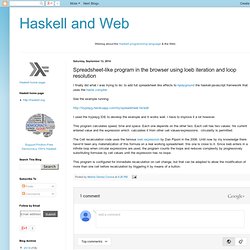
I have to improve it a lot however. This program calculates speed, time and space. Each one depends on the other two. The Cell recalculation code uses the famous loeb expression by Dan Piponi in the 2006. This program is configured for immediate recalculation on cell change, but that can be adapted to allow the modification of more than one cell before recalculation by triggering it by means of a button. Yesod Web Framework Book- Version 1.2 (beta) Using Ajax with a Scaffolded Site. This is cookbook recipe, also available from the Wiki.
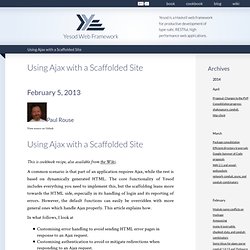
A common scenario is that part of an application requires Ajax, while the rest is based on dynamically generated HTML. The core functionality of Yesod includes everything you need to implement this, but the scaffolding leans more towards the HTML side, especially in its handling of login and its reporting of errors. However, the default functions can easily be overridden with more general ones which handle Ajax properly. This article explains how. In what follows, I look at Customising error handling to avoid sending HTML error pages in response to an Ajax request.Customising authentication to avoid or mitigate redirections when responding to an Ajax request.Testing using Yesod.Test.An example handler and client-side code, to illustrate the choices on which the rest of the discussion is based.
A caveat To give concrete examples, I have had to make choices about the way Ajax calls are done. Error Handler Login. The Fay Programming Language — A Haskell subset. Yesod vs. node.js comparison. Three Haskell web frameworks « Aidan Delaney’s weblog. This model-view-controller pattern has been kicking around for quite some time now.
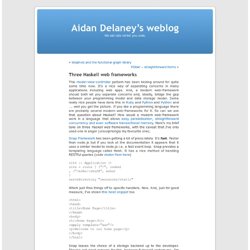
It’s a nice way of separating concerns in many applications including web apps. And, a modern web-framework should both let you separate concerns and, ideally, bridge the gap between your programming model and data storage model. Some really nice people have done this in Ruby and Python and Python and …. well you get the picture. Is Haskell good for web development? May 12, 2012 – 2:49 pm Tags: Haskell, Yesod I’ve been trying out Haskell for developing a web application, using the Yesod framework.
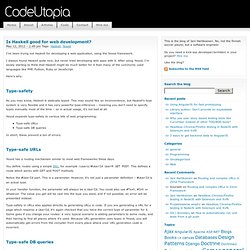
I always found Haskell quite nice, but never tried developing web apps with it. After using Yesod, I’m slowly starting to think that Haskell might be much better for it than many of the commonly used languages like PHP, Python, Ruby or JavaScript. Here’s why: Type-safety. The Limitations of Haskell. Haskell is an amazing programming language that has helped us create an amazing web framework.
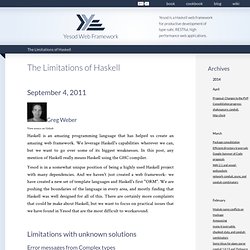
We leverage Haskell's capabilities wherever we can, but we want to go over some of its biggest weaknesses. In this post, any mention of Haskell really means Haskell using the GHC compiler. Yesod is in a somewhat unique position of being a highly used Haskell project with many dependencies. And we haven't just created a web framework- we have created a new set of template languages and Haskell's first "ORM". We are pushing the boundaries of the language in every area, and mostly finding that Haskell was well designed for all of this.
Limitations with unknown solutions Error messages from Complex types. The Architecture of the Mighttpd High-Speed Web Server. Mighttpd. Hakyll - Home. Static sites are fast, secure, easy to deploy, and manageable using version control. Hakyll is a Haskell library for generating static sites, mostly aimed at small-to-medium sites and personal blogs. It is written in a very configurable way and uses an xmonad-like DSL for configuration. Integration with pandoc gives us markdown and TeX support, including syntax highlighting and other goodies. Write your content in whatever format you prefer Write your content. Haskell. Yesod Web Framework for Haskell. Snap: A Haskell Web Framework: Home. Getting Started with the Haskell AWS Lambda Runtime. Introduction We were there when Werner Vogels announced the new custom lambda runtimes on stage, and we couldn’t have been more excited.

It was definitely one of our favorite announcements that morning. We have been trying Haskell (and other flavors of Haskell, like Eta and PureScript) on AWS lambda since we started working on Serverless more than a year ago. From the beginning we felt like Haskell fit like a glove in AWS Lambda — it produces fast and reliable binaries and it’s a pure functional language! There’s nothing like a pure functional language to write Lambda Functions, right? Well, the reality is that Haskell didn’t work as well as the supported languages did.
After the announcement we couldn’t stop ourselves from running to one of those cubicles at the Venetian and writing a Haskell runtime. Setting up the environment This guide assumes that you have the Stack build tool installed. Curl -sSL | sh Haskell compiles to native code, which is super efficient.